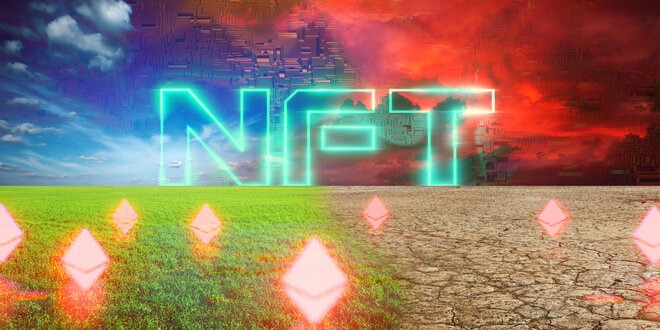Non fungible tokens or NFTs have increased in popularity over the last couple of years. NFTs are primarily used as an avenue to convey ownership of digital assets and they have occasionally increased the level of fine art. But there is an extra hidden cost that comes with NFT and that is the environmental impact of NFT on using the blockchain to transfer assets. Here is an NFT environmental impact comparison. Also if you are wondering why do NTFs use so much energy, you will find the answers in this article.
How NFTs Work?
Before we directly get into the environmental impact of NFT, it is important for you to know how NFTs work. An NFT uses the blockchain technology to offer ownership of an asset. They hold specific data that makes them work a bit differently from digital currencies. Most crucially, you cannot replace an NFT with a similar NFT as they are non fungible. Any BTC is worth the same as any other Bitcoin, but that is not the case with NFTs.
Most NFTs use the Ethereum blockchain for transferring ownership. When someone purchases an NFT on the Ether blockchain, they send ETH to the present owner or the marketplace that supports the transaction. In return, they get the NFT in their wallet. Portions of the payment include the “gas fees” or the service charges related to the transfer. Those charges go to the owner of the network of the computer that is used to confirm transactions on the blockchain.
If you own an NFT, it is similar to owning the rights to a collectible or even a piece of art. It is practically impossible to prevent anyone from making a digital copy of a publicly displayed video file or jpeg. Owning their rights is more similar to owning the original painting by an artist, while the copies are more likely owning a cheap posted print. Since we know about blockchain environmental impact, it is time to see the NFT environmental impact.
Environmental Impact of NFT: Do They Harm The Environment?
Talking about NFT environmental impact, by now you may have understood the idea of NFTs and how they can impact the environment. Even though non fungible tokens themselves do not create any environmental impact, the impact on our climate is connected to how an NFT is produced.
The way that NFTs are formed is highly energy-intensive. Most non fungible tokens are minted using the PoW (proof-of-work) functioning method, which uses big amounts of electricity. Any energy-intensive process, related to crypto or otherwise, can exacerbate climate alterations by adding carbon dioxide emissions to the atmosphere. However, there are other more environment-friendly ways to mint NFTs, in general, methods using PoS (proof-of-stake).
There is no huge NFT energy consumption when you mint it. Keep reading to find out more about how the production of NFTs consumes energy, and learn the choices that are available to acquire NFTs without harming the environment.
What Causes The Environmental Impact Of NFT?
There is no direct environmental impact of NFT, but how they are minted can have substantial environmental consequences. Let us have a look at how using the PoW mechanism NFTs are being generated for understanding how their production utilizes so much energy.
NFT is listed in a digital marketplace
Usually, before any non fungible token is minted, it is listed in an NFT marketplace. While listing an NFT is not energy-intensive, the location of the NFT listing will generally evaluate how much energy the minting process will need. Selecting an NFT marketplace, such as OpenSea, that hosts the Ethereum platform, which uses PoW (proof-of-work), implies that the minting process will be energy-intensive, at least for now.
NFT is purchased
The buying of an NFT is often the accelerator for the NFT to be minted. Using PoW (proof-of-work), the NFT is minted—”mined”—by digital currency miners who control extensive computing resources. The mining process is energy-intensive, along with specialized computing hardware using vast quantities of electricity. Miners race to efficiently solve complicated math issues, thus earning the right to mint the NFT.
NFT is stored or transferred
Once the NFT is bought, you can store the NFT or you can transfer it to another person. If you transfer the NFT to another NFT marketplace that uses PoW (proof-of-work), then the same energy-intensive process that was used to mint the NFT is reciprocated for the transfer. Simply keeping an NFT does not consume energy.
You may be thinking exactly how the mining process exhausts energy. Only miners that have the most computing power are likely to succeed at resolving the complicated math problems the fastest, implying that miners must function a large quantity of computing hardware, and use a lot of electricity. A global network of miners is fighting to validate blocks of transactions, that include NFT transactions, needing every participating miner to extensively exhaust electricity, although only one miner is chosen to validate each latest block of transactions.
Each transaction on the Ethereum PoW (proof-of-work) platform, which includes each NFT transaction, uses over 260 kilowatt-hours of electricity which is equivalent to the electricity used by an average U.S. household for a period of 9.05 days.
Environmental Impact of NFT: Can NFT Use Less Energy?
Transferring or minting an NFT is usually energy intensive, but does not require to be. Blockchain channels using the PoS operating mechanism that can generate NFTs without excessively utilizing electricity and negatively affecting the environment.
The PoS mechanism utilizes less energy in comparison to PoW (proof-of-work) as it does not need the extensive use of computing hardware. Whereas miners who take part in a proof-of-work blockchain network are driven to consume electricity in an attempt to successfully mine a block, validators who contribute to a proof-of-stake blockchain are obligated to stake and agree to not trade or sell their digital currency holdings. Enacting a staking need for blockchain validators is a way to safeguard a blockchain without needing the participants of a network to excessively to consume energy.
NFTs, in other creative ways, can be less harmful to the environment. Here are some choices:
Use renewable energy
Miners that use proof of work consensus to generate NFTs can use renewable sources of energy. While PoW mining is energy-intensive, the source of the needed energy can be free of emission. Solar power is a famous choice, but other options include hydro and wind generated electricity.
Invest in renewable energy
With some NFTs selling for impressive values, it is possible to devote a part of those proceeds to renewable energy investments. A huge scale shift to renewable energy could eliminate or curb the environmental impact of NFT.
Buy carbon offset credits
NFT investors who aim to offset the environmental impact of NFT buy can purchase carbon offset credits. While buying carbon credits does not actually decrease carbon dioxide emissions, it offers a financial incentive for others to minimize their complete emissions on an annual basis.
Conclusion: Can Environmentalists Invest In NFTs?
If you care about combating climate change but wish to invest in NFTs, then you might feel that those two aims are at odds. You can safeguard the environment and still buy an NFT, but to ignore using almost nine days’ worth of electricity, you cannot buy just any NFT.
If you are committed to adjusting your investment portfolio with your attitude towards climate change and considering the environmental impact of NFT, then try to invest only in NFTs that are developed using the Proof of Stake (PoS) consensus method. While that presently limits your options for purchasing, the limitation is likely only temporary. After the Ethereum platform fulfills its transition to proof of stake, then environmentalists can purchase NFTs using Ether (ETH) with a clear conscience.
- Top 7 Best VPN For China: Tested And Working - 19/10/2023
- 7 Best VPN For Canada: How To Dodge Five-Eye Security - 16/10/2023
- Top 5 Best VPN For UAE & Dubai That Accepts Crypto - 15/10/2023
 Crypto Venture News One stop Crypto Track Down
Crypto Venture News One stop Crypto Track Down 






